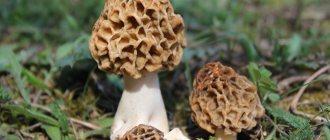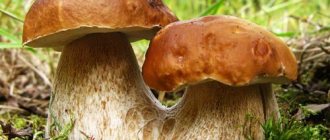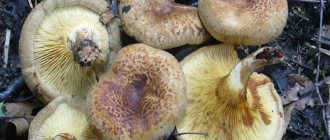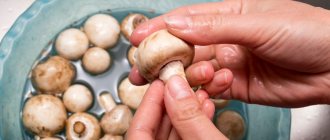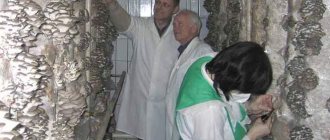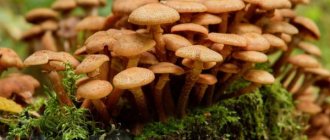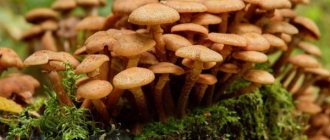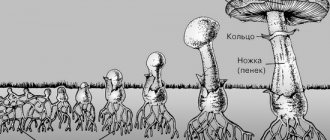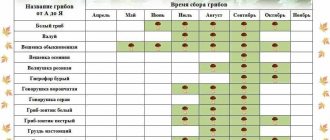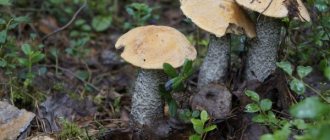Autumn is a real mushroom time. Many people, having gone on vacation in nature, will go to collect autumn mushrooms and will happily spend a lot of time searching for them. And there are those who know exactly what edible specimens look like and where it’s best to look for them, and will not miss the opportunity to go on a “quiet hunt” again.
What could be better than wandering through the forest among fallen yellowed leaves on a warm sunny day? Mushroom picking is a great activity for the whole family. Mushrooms are like small berries that can be hard to find. Some species can hide in leaves or under moss, others grow on trees. You can find them under birch trees, poplars, oaks, pine trees, or even under an apple tree.
There are many varieties of mushrooms. You can find tubular species: boletus, boletus, aspen boletus, boletus, or lamellar: saffron milk caps, russula, and boletus. Popular ones also include honey mushrooms, chanterelles, oyster mushrooms or morels.
Autumn mushrooms: their types and tips for collecting
What weather is needed for mushroom growth: optimal temperature
Everyone knows that honey mushrooms grow in large colonies, settling on rotten stumps and fallen trees.
To meet such a friendly “family” on your way is real luck. However, it happens that when we come to the forest, we come across a meager harvest of overgrown honey mushrooms. Most likely, this is due to unsuitable weather conditions, as well as the choice of the wrong time to go for fruiting bodies. What temperature is considered optimal for the growth of honey mushrooms in the forest? It must be said that temperature is one of the most important factors affecting the growth of fruiting bodies. Thus, for most mushrooms, including some types of honey mushrooms, the average temperature for abundant growth and fruiting is 15-26°C.
However, spores of autumn, spring and winter honey mushrooms begin to grow already at a temperature of 3-5°C. But high air temperatures have a negative effect on the growth of fruiting bodies. So, at 30°C and above, the growth process stops completely, and if there is also drought, the mushrooms begin to dry out and deteriorate. In addition, sharp and strong fluctuations in day and night temperatures also greatly slow down the growth of honey mushrooms.
If the air temperature does not drop below 18-20 degrees for 10-14 days, and there has been heavy rain, then you can count on a mushroom harvest. The higher the soil and air humidity, the more intensively the mycelium feeds and develops. As a result, more and more fruiting bodies appear on the surface of the earth.
Many mushrooms begin to grow at temperatures of five degrees. At temperatures above thirty degrees, growth stops completely. At a constant temperature of at least 18 degrees for two weeks and sufficient humidity, intensive growth of mushrooms begins. At the optimal temperature, russula grows completely in two days. But if there is a significant temperature fluctuation between day and night, then the growth rate is noticeably reduced.
The next important factor is soil and air moisture. In almost all fruiting bodies, the mycelium is located in the upper layers of forest soil at a depth of no more than ten centimeters. At optimal temperature and high humidity, the growth rate increases, and dry soil sharply reduces the growth rate. If, after an intense rainy period, drought occurs suddenly, the growth rate of fruiting bodies decreases.
The reason is that when the soil is saturated with moisture and low air humidity, intense evaporation of moisture begins. It is believed that for optimal growth, the required air humidity in the ground layer should be at least seventy percent.
On average, we can assume that most mushrooms in our forests grow to average size in five or six days. Then another ten to fourteen days pass until the fruiting body completely decomposes. Mushrooms with dryish flesh live several days longer. The leg stops growing two days earlier than the cap.
- Oyster mushrooms grow no more than three days.
- Autumn honey mushrooms grow in just three days.
- Boletuses grow in four days.
- Butterflies grow in five days.
- Chanterelles mature in seven days.
- Boletus grows for at least nine days
- Boletus mushrooms grow in ten days.
- Milk mushrooms grow in twelve days.
Growth rate in different species
If the air temperature does not drop below 18-20 degrees for 10-14 days, and there has been heavy rain, then you can count on a mushroom harvest. The higher the soil and air humidity, the more intensively the mycelium feeds and develops. As a result, more and more fruiting bodies appear on the surface of the earth. They usually grow in “layers”, that is, there is a sequence of fruiting in different species. Boletus, boletus and boletus grow the fastest. Basically, it takes them 2-3 days to reach medium size. The same amount of time is needed for lamellar russulas, champignons and saffron milk caps.
How fast they grow
The noblest and most desirable creatures develop much more slowly. The porcini mushroom has a very dense and thick stem. It is from the stem that all mushrooms begin to grow, so white mushrooms take longer than boletus mushrooms. But the adult fruiting body of boletus is significantly ahead of other species in weight and size. But sudden frost or prolonged lack of moisture can affect how quickly mushrooms grow. In optimal conditions, in warmth and sufficient humidity, entire hordes of edible mushrooms grow in the forests.
Stages of growth
Mushrooms are characterized by gradual growth. All species have the following stages of development:
- Growing spores. Once in a favorable environment, they first swell, and then growth tubes and primary mycelium appear.
- An increase in mycelium that divides and forms branches.
- Intensive growth, accumulation of nucleic acids. During this period, the growth of the fungus reaches its peak.
- Mycelium aging. Growth slows down, new spores appear for further reproduction.
- The death of the mycelium.
The growth period of autumn mushrooms: how quickly mushrooms grow in September after cutting
So we learned how quickly mushrooms grow. Now we wait for the rains, and after them we go into the forest. However, they cannot be collected everywhere. You should not eat mushrooms grown on the side of roads. It is not the best option to collect them in forest belts. A mushroom is a kind of natural “vacuum cleaner” that “sucks in” not only useful substances, but also harmful ones!
What is the growth rate of mushrooms? Favorable and unfavorable conditions for the appearance of mushrooms. What affects the growth rate of mushrooms?
Do you know what the growth rate of mushrooms is? There is no clear answer to this question. No mushroom picker can definitely name the time when mushrooms appear after rain. Fans of quiet hunting have noticed that small mushrooms become adults in three to ten days. But this is not a dogma at all - it all depends on many factors.
We can say that for summer mushrooms the most suitable air temperature is 23°C, and for autumn and spring mushrooms - 12°C. However, these are not all weather conditions that allow abundant fruiting of mushrooms. So, we smoothly moved on to, perhaps, the most important condition necessary for the growth of honey mushrooms in the forest.
For the growth and development of the mycelium, regular air flow is also needed. In most cases, the mycelium passes through the upper layers of the soil and deepens to 6-13 cm. If unfavorable weather sets in - severe drought, frost, hardening of the soil, excessive humidity, then it begins to develop poorly and becomes dehydrated, but this does not affect its stability. For optimal growth and development of honey mushrooms, air humidity in the upper layers of the soil should be from 50 to 65%.
Thus, it becomes obvious that favorable weather for honey mushroom growth includes warmth and moisture. What can you say about the growth rate of honey mushrooms? Unfortunately, there is no clear answer to this question, because the process is influenced by a number of factors. Even experienced mushroom pickers are not able to give specific numbers.
We often use the phrase “grow like mushrooms” in our speech. As you can see, this process goes quite quickly. It is noteworthy that the growth of the stem of the fruiting body stops 1-2 days earlier than the growth of the cap. Unfavorable weather, as well as the presence of insects or worms, significantly weaken the growth of mushrooms.
Among all types of honey mushrooms, autumn ones are considered the most popular. These fruiting bodies also have their own favorable “atmosphere” for active fruiting. Many mushroom pickers love to collect these mushrooms, because in terms of taste they belong to category 3. They make very tasty and aromatic dishes, as well as preparations for the winter.
Many people are interested in how quickly honey mushrooms grow in September, so as not to “miss” the moment of going to the forest? It must be said that autumn honey mushrooms grow even faster than representatives of other species. If the remaining fruiting bodies reach large sizes in 9-12 days, then autumn honey mushrooms mature in 6-8. However, the rate of mushroom growth in autumn also depends on a number of factors.
For example, for abundant growth, favorable weather is required - an average temperature of 12 ° C (small differences between day and night indicators are allowed), as well as moderate rains. In addition, the condition of the stump or tree also affects growth and fruiting. So, if the wood is completely rotten, then the growth rate of honey mushrooms increases. The fact is that such stumps open up a greater flow of air and moisture, which means the mushrooms grow faster.
Many experienced mushroom pickers note that autumn honey mushrooms are ready for collection in 1.5-3 days. If today you find a stump where you can barely see them, then feel free to come to this place tomorrow. The fruiting bodies will be ready to go into your basket. In addition, autumn species of honey mushrooms also reproduce quite quickly.
Within a day, you can find a large number of representatives of the mushroom “kingdom” on an empty stump or tree. Mycological specialists note that already on the second day, the autumn honey fungus reaches 5 cm in length, and the diameter of the cap is about 2 cm. After another 2-3 days, these figures increase by 1.5 cm.
It must be said that all mushrooms, having completed fruiting, begin to age and decay the very next day. This process occurs very quickly, but autumn species have an advantage in this case. They age more slowly, maintaining their elasticity and fleshiness longer. This is due to cool weather as well as sufficient humidity.
How quickly do honey mushrooms grow in the fall after rain? In this case, the first 2-3 days after the last drop falls on the soil are the most suitable for going to the forest. It has been established that the highest growth rate of honey mushrooms occurs precisely in the first days after rain. Keeping this in mind, you will be able to correctly calculate the time when you can go into the forest for a new harvest.
In addition, another favorable phenomenon for the growth of autumn mushrooms is fogs, which can be observed throughout September and October. Frequent fogs also have a very beneficial effect on the “richness” of mushroom harvests, because the soil is saturated with a sufficient amount of moisture. In this case, he recommends planning a trip to the forest early in the morning, when the sun has not yet had time to illuminate it with direct rays.
How long does it take for mushrooms to grow after cutting?
Perhaps none of the plants widely used by humans for food grows as quickly to a ripe state as a mushroom. Hence the expression “grows like a mushroom.” However, in the minds of mushroom pickers, the growth rate of mushrooms is usually exaggerated. This happens because some of the mushrooms go unnoticed during collection. When visiting the site again after a day or two, mushroom pickers find mushrooms of considerable size. Cap mushrooms grow very quickly. Over the course of one, several days, and even part of a day, porcini mushrooms, aspen mushrooms and boletus mushrooms significantly increase in size. Most mushrooms grow to medium size in 3-6 days. Under favorable weather conditions, boletus, boletus, and russula can be collected within a day or even a night after they appear on the soil surface. The fact is that the fruiting bodies of the most famous cap mushrooms first form underground, grow there for a long time and emerge almost fully formed to the surface. However, even after this, their growth until full ripening can continue for 8-12 days. Infection with fly and mosquito larvae slows down or stops the growth of mushrooms. During the day, the mushrooms grow by an average of 1-1.5 centimeters in the total height and diameter of the cap. But even among mushrooms of the same species, for example, boletus, the daily growth ranges from 3 millimeters to 3 centimeters, which is due to their individual characteristics and condition. In the first 5-8 days, the growth of the mushroom, both in total height and in diameter of the cap, occurs quite evenly. The growth of mushrooms in height stops one to two days earlier than the growth of the cap in diameter. A day after growth stops, the mushroom is destroyed. Some argue that there is no significant difference in the growth rate of mushrooms at night and during the day. Sometimes there is a noticeable increase in fungal growth after precipitation. And yet, mushrooms appear to grow most at night. You walk through the forest in the evening - there are no mushrooms, it’s empty. And in the morning, the young mushrooms are right there, asking to be put in the basket. So light has little effect on the development of mushrooms, because the mushroom is a child of the shadow. In the summer-autumn period, the average weight of fresh mushrooms on the fourth day of their growth is expressed by the following values: porcini mushroom - 160 grams, boletus - 74, boletus - 45, oiler - 35, moss - 33, chanterelle and goat - 9, milk mushroom - 79 , volushka—17, russula—12 grams. In which forests are the conditions most favorable for mushroom growth? Some argue that mushrooms grow better in young forests, in which the mycelium filaments get along better with young, small, soft-barked tree roots. These roots are located in the top layer of soil and are accessible to fungi. In older trees, the roots are located deep in the ground, so they are less accessible to the mycelium. The practice of mushroom pickers confirms the opposite. There are fewer mushrooms in young forests than in old ones. The first porcini mushrooms, aspen mushrooms, boletus mushrooms, boletus mushrooms and others, as a rule, appear on large trees and most often in the immediate vicinity of them, where there are significantly fewer young, small roots at the soil surface. At the same time, these mushrooms are almost impossible to detect in young forests. Somewhat later, approximately in the second half of August - early September, mushrooms grow relatively evenly in both forests. At the end of the season, mushrooms are again found more in old forests than in young ones. The only exceptions are boletus and saffron milk caps, which grow better in young growth and on the edges. The collector is sometimes struck by the unevenness of the mushroom harvest, that they seem to “wander” from one place to another, from one forest to another. This is explained by changes in fungal growth factors. For example, dry, hot weather set in, and there were almost no mushrooms in the elevated, dry places, but in the lower areas of the forest, where excess moisture from the soil evaporated, mushrooms appeared as if by magic. Therefore, mushrooms cannot tolerate either excessive dampness or dryness.
What factors influence growth?
The growth of this gift of the forest is determined by many environmental conditions. Without the necessary parameters, spores will not even be able to grow. The main factors affecting the fungus include:
- Humidity is the main factor in the appearance of the gift of the forest, because its body has no protection from moisture evaporation and it needs to receive it from the environment. Moistening the soil promotes rapid growth, and during the dry period fruiting bodies are not formed. Rain is a sign that mushrooms will soon appear. After just a few days you can go into the forest, but it is better to wait 5-7 days, when the peak of growth occurs.
- Temperature. Most species love warmth from 18 to 25 degrees. Summer species adapt well to 25-30 degrees. The most frost-resistant representatives last until November, when the temperature drops to 5 degrees Celsius.
- Light. On the one hand, its presence promotes the growth of mycelium, but on the other hand, with prolonged exposure to direct sunlight it dies. Diffused rays of the sun are considered optimal.
- The soil. The mycelium feeds on dead organic matter, so mushrooms often appear on decaying tree trunks and fallen leaves.
Folk signs
People have long noticed a connection between various phenomena and the period of mushroom growth. Many mushroom pickers follow these signs and harvest bountiful harvests.
Once the mushroom is torn from the ground, it perishes forever. This sign is a real rule. When you pull out a mushroom, serious damage is caused to the mycelium and it may die. You need to cut off the forest's bounty with a knife and sprinkle the cut with earth so that next year the place will be productive again.
Midges are flying - prepare some baskets. The midge becomes active in the fall, when it senses the approaching cold. This is when most of the forest's gifts appear.
Based on golden pollen, this year they are blowing in droves. Pine needles are not golden in color. But it is noticed that once every 3 years, when the needles fall, golden pollen forms on them. At this time, record harvests of butter are harvested.
If the cloud clings to the tops of the forest, then prepare a basket. Low clouds indicate fog, which indicates high humidity. Moisture is the first condition for the growth of forest products.
Quiet rain and no winds - it’s time to get ready for the forest. Rains without wind and hurricanes are characteristic of autumn - the mushroom season.
Forest paths in the molds and - there will be a lot of mushrooms. Mushroom is a type of mold, so they appear in the same conditions.
It rains in the evening - wait for mushrooms in the morning. Indeed, these organisms grow quickly, and most likely at night.
The mushroom has outgrown - you have found danger on your nose. Old forest products are fraught with many dangers, because they have already begun to die off and accumulate harmful substances. Plus, worms love them.
How quickly honey mushrooms grow in October and the growth time of winter mushrooms
What can we say about October - how quickly do honey mushrooms grow this month? First of all, you need to take into account the characteristics of the local climate. Sometimes autumn species of honey mushrooms can be found even in early November, if the weather permits. But in the month of October, abundant growth of fruiting bodies is observed with the onset of the so-called “Indian summer”.
But for winter species, honey mushrooms require completely different weather, because they are collected throughout the winter. How quickly do winter mushrooms grow in the forest? Interestingly, they grow even when the air temperature reaches 7°C. Despite this, their growth rate is no different from other types of honey mushrooms. Unlike them, winter mushrooms are not afraid of frost, but are only covered with an ice crust. Then, with the onset of a thaw, they come to life and continue to grow, while maintaining their original appearance and elasticity.
To what temperature can mushrooms grow during the first frost?
Very few types of mushrooms can withstand the cold. Therefore, for most lovers of “silent hunting”, the mushroom season ends with the arrival of November. But this is not entirely reliable. Since there are species that grow exclusively after the first frost.
A striking representative of frost-loving mushrooms is the winter honey fungus.
It grows mainly in deciduous forests on trees. In addition to their bright appearance, they have excellent taste, so hunting for them makes sense. The mycelium does not grow directly in sub-zero temperatures, but frost only slows down its growth and does not stop it. Therefore, when it gets a little warmer, the winter honey fungus thaws and continues to grow.
Another mushroom that can be found in winter is the winter oyster mushroom.
It likes to grow on dried aspen and birch trees. It is extremely rare in other species.
You may be interested in:
Where and when to look?
We can conclude that many mushrooms can be found after rain, especially after 5-7 days. But besides this, you need to know where and when to collect the gifts of nature. The forest is the main place for collecting such crops. Champignon lovers need to know that their distribution area is the wet steppe.
Experienced mushroom pickers know that they need to look for mushrooms in places where there is little grass, because it is their competitor. The presence of lichens, moss, and fallen leaves indicates the presence of forest gifts.
It is also important to remember the seasons of greatest harvest for mushroom pickers:
- end of May-mid June;
- end of July-August;
- mid-October-early November.
Mushrooms. In what weather do they speed up and when do they freeze completely? As it turned out, there is a direct relationship between weather conditions and In addition, there are a lot of factors that also affect the development of mycelium and the appearance of fruiting bodies.
Fruiting bodies are usually called formed fungi that grow from the mycelium. The mycelium, in turn, is an interweaving of thin white threads. All of it is located underground, in the fertile layer of soil and hidden from human eyes. It is the conditions in which the mycelium develops that determine how quickly mushrooms grow.
How forest mushrooms grow
Most forest mushrooms have a perennial mycelium that is adapted to unfavorable environmental conditions, drought and frost. The growth of mushrooms stops if there is a lack of moisture in the soil, but the development of the fruiting body does not stop completely. Young mycelium is much less resistant to frost, which has a detrimental effect on developing mushrooms. Severe and early cold snaps can completely stop the growth of the fruiting body.
When the mycelium reaches sufficient development, the direct formation of the future fungus begins. The threads gradually intertwine with each other, first turning into small lumps, from which the stem and cap are then formed. Young mushrooms reach medium size in 4-5 days. After another week, the process of decay of the reproductive part of these forest inhabitants begins. So mushrooms are rather short-lived inhabitants of the forest.
The growth rate of fungi is directly affected by humidity, soil and air temperature, and the nature of the area where the mycelium is formed. The fastest growing plants are boletus, boletus and russula. Porcini and boletus mushrooms fully ripen in about a week. But chanterelles grow relatively slowly. Spores also form in young mushrooms, which themselves become the source of new mycelium. The development cycle repeats itself - to the delight of mushroom pickers.
You need to know approximately the time and place of mushroom growth so as not to miss picking mushrooms of one type or another. For the growth and development of the vast majority of fungi, loose soil rich in organic residues or forest litter, a sufficient amount of moisture and heat are required. However, different types of mushrooms have different heat and moisture requirements.
That is why in our forests, from early spring to late autumn, some types of mushrooms are replaced by others.
Each type of fungus develops at certain times, which vary somewhat, depending on meteorological conditions. The mushroom season opens in the second half of April - the first half of May, morels and strings. In May - June, meadow mushrooms, money mushrooms (collibia), talkers, russula, and puffballs grow.
In the second half of June, for a short period of time (about 10 days), boletus, boletus, porcini and other valuable edible mushrooms develop - the first “layer” of them, and in mid-July the second “layer” of these mushrooms develops, and this time lasts up to three weeks
And finally, from mid-August to September there is a third “layer” of mushrooms such as porcini, boletus, aspen, autumn boletus, and saffron milk caps. The composition of mushrooms during this period is more diverse and their quality is higher than in previous ones. From the end of September until the snowfalls, numerous rows, hygrophores, moths, winter mushrooms and others develop. Some of the mushrooms of this period can be collected in January - February during thaws.
The qualitative composition of mushrooms, their abundance and productivity are significantly influenced by the meteorological conditions of the year (especially the previous autumn), the type and condition of the forest. Excessive moisture or dryness does not promote mushroom growth. The greatest number of mushrooms grow in mixed forests consisting of pine, oak and accompanying deciduous trees and shrubs. In mature forests, more mushrooms develop than in small forests.
Time and place of growth of mushrooms - The most favorable temperature for the development of mushrooms is 22–25 °C and humidity 80–85%. In dry years, mushrooms should be looked for in lowlands, on the edges of swamps, on shady northern slopes, in dense forests, under the canopy of trees. On the contrary, in wet and cold years, mushrooms grow in open, heated clearings, away from trees, along sparse edges, roadsides and forest paths.
Time and place of mushroom growth - Mushroom harvests fluctuate sharply depending on the weather conditions of different years. On average, abundant harvests occur once every four years. But even in the most unsuitable years for mushroom growth, an experienced mushroom picker does not return from the forest without spoils from a “silent hunt,” because mushrooms growing on stumps, logs, in hollows and on tree trunks are less dependent on meteorological conditions than soil and litter ones. These are the scaly and sulfur polypores, the common liverwort, the ram mushroom, the coral-shaped hedgehog and others, you just need to know them.
The best video film about mushrooms from Tatyana
Autumn is the rainy season, which means mushroom season! Each of us who visited the countryside during this wet season could see a huge number of mushroom pickers with large baskets full of this delicious gift of nature. And many people like to spend their day off in unity with nature, walking in the forest and stocking up on porcini mushrooms, honey mushrooms, russula, and saffron milk caps.
But when should you go after them? While experienced mushroom pickers know how long it takes a particular mushroom to grow, beginners often rush into the forest immediately after the rain, but collect nothing but dirt on their shoes. Therefore, today we’ll talk about when to go for the gifts of nature after the rains.
When the frost hits
Few of these forest dwellers can survive severe frost, and most mushroom pickers believe that the season ends in November. But that's not true.
One of the most cold-resistant mushrooms is honey mushrooms. The best temperature for their growth varies in the range of +8 ... +12 oC. Their cheerful families grow in the forest even after serious frosts. At what temperature do mushrooms grow in autumn? Winter honey mushrooms, for example, can be found at sub-zero temperatures, even under snow.
Winter oyster mushrooms are also not afraid of frost, which can be harvested not only in November, but also in January.
When to go to the forest
Please note that in forests mushrooms can grow at a rate of up to several cm per day. The ranking of fruits by growth rate is as follows:
- Boletuses.
- Boletuses.
- Boletus mushrooms.
- Honey mushrooms.
- Chanterelles.
Fungi, like any other living organisms, have a number of growth characteristics. Therefore, depending on the type, the speed of fruit ripening is also different. For example, if boletuses are able to fully form after just 5 days, then chanterelles will gain a maximum of a third of these indicators over the same period.
- From the end of May to the end of June.
- Several weeks starting at the end of July (weather permitting).
- From the moment the leaves begin to fall from the trees.
Therefore, if you want to try yourself as a mushroom picker, try to go on vacation between the end of May and the end of September. Then you will have enough time to replenish your home supplies with mushrooms in a variety of forms, from frying to canning.
However, for the full growth of mushrooms, the season alone is not enough. Threads of micelles develop only if nature creates certain conditions for this. In particular, three of them can be distinguished:
- Abundance of air.
- Appropriate temperature.
- Optimal humidity.
As you know, mushrooms grow after rain. It is not surprising, because during this period the soil is saturated with moisture, which is a prerequisite for the development of micelle threads. However, good temperature is equally important. It is believed that fruits develop best in a temperature range of 10-20 degrees Celsius.
However, it is important to know that if the necessary weather conditions have arrived, the mushrooms will not appear immediately within the specified period. For their formation, you need to wait until the mycelium is fully formed, so the fruits can appear on different days of the “mushroom” period. The process of reproduction and development of mushrooms occurs completely independently; humans cannot in any way speed up the process of their maturation.
Remember, in order to collect a full harvest, you need to walk through the forest a few days after the rain. For example, the same boletus mushrooms can appear on the surface 10 hours after the last drop falls on the ground. Again, it is important to pay attention to which particular “mushroom” period you are going into.
Are you an avid mushroom picker or are you just planning to start an exciting search? Then this article is for you! How much do you know about these amazing organisms? Like mushrooms in the forest? Where and when do they appear? But first things first.
When to collect boletus mushrooms in the fall
Boletus mushrooms, especially young and strong ones, are in no way inferior to white ones - even boiled, dried, or fried. And if they go in layers, then you can collect more than one bucket of them in a relatively small forest.
According to popular belief, the first boletuses appear when the mountain ash blooms, and then they do not leave forest glades and birch groves all summer. Unless, of course, the summer was too hot and dry. But the summer boletus has one drawback - the worm really loves this tasty mushroom. So the mushroom picker has to reluctantly throw away one mushroom after another.
In autumn, boletus flowers are clean and strong. And besides, their special appearance appears - with a thick stem and a dark cap, the taste is practically no different from the white one. Finding it, however, is not easy in the fallen leaves. But if you come across one, then you can find a dozen more around it.
At what temperature do mushrooms grow in autumn (boletus mushrooms)? Their temperature regime is almost the same as that of whites. For boletus, 10–12 degrees Celsius is quite enough, only these mushrooms love wetter weather, not prolonged rains, but thick autumn fogs. And if the autumn is dry, then boletus mushrooms should be looked for in damp places, in lowlands and even in a swamp.
A good mushroom picker knows at what temperature mushrooms grow. In the fall, in the forest, he will quickly fill a basket, or even take out a bag - don’t leave boletus and boletus, aspen and boletus, milk mushrooms and capillaries under the fir trees and birches! And if honey mushrooms attack, there may not be enough packages.
Structure
In fact, most of the plant is in the soil. This is mycelium or mycelium, which consists of hyphae - mushroom threads (like the whole mushroom). Then a clot is formed in it, from which what we collect grows - the fruiting body. It contains a stem and a cap. On the inner surface of the latter you can see tubes or plates, and occasionally spines with needles.
Scientifically it is called a hymenophore. In this place, spores are formed, which mushrooms use to reproduce. There are countless of them. Mushrooms are also propagated under artificial conditions by pieces of mycelium, such as champignons. As we can see, the upper part of the mushroom is a kind of “warehouse” in which useful substances are stored.
Forest mushrooms are divided into edible, inedible and poisonous. Therefore, before getting ready to “hunt”, it is better to carefully study the corresponding encyclopedia with photographs. They even say that every edible mushroom has a poisonous counterpart. But this is nothing more than fiction. If you doubt the edibility of a mushroom, look at the inside surface of the cap - under no circumstances should it be pink.
How and where to collect
Everyone probably knows how quickly mushrooms grow in the forest after rain. In general, under optimal conditions (humidity and temperature), they can be found everywhere. A good mushroom harvest is usually preceded by a period of light rains. If there is an abundance of moisture in the forest, it is better to look for them in open sunny places and hills.
If you find them in your forest, feel free to go “hunting”. It is hardly worth collecting mushrooms longer than their life cycle - 10-12 days. Temperature is also important for optimal growth. At best, it should be 18... 20 o C.
Mushrooms can be trimmed or unscrewed. You should not pull it out along with the mycelium. It is better to cover the place where it grew with moss.
Favorable temperature conditions in spring
As soon as the snow melts and the air temperature rises to 5–10 degrees Celsius, morels can be found in the forest.
Very often they are found right in melt puddles. Another favorite place for their growth is the space near deciduous trees.
Along with the morels, lines appear.
The common species prefers to grow under coniferous trees. However, giant stitch is found mainly in mixed and deciduous plantings. When harvesting the mushrooms listed above, be careful, as they are conditionally edible. They can be consumed only after preliminary heat treatment.
Chanterelles
They grow with the appearance of the first yellow leaves. The peculiarities of the mycelium are such that it takes a long time to gain strength, and a well-developed one begins to actively bear fruit closer to autumn. Therefore, the peak of growth often occurs in September with its low temperatures and frosts. Therefore, it is believed that chanterelles grow very slowly. In fact, their growth is no different from other species, but a significant slowdown is observed due to low autumn temperatures.
No wonder they say: “They grow like mushrooms after rain.” The time for growth and development of the fruiting body from the appearance of the rudiments to its maturation is usually 10-14 days. In this case, of course, the temperature and humidity of the soil and air matter. For comparison, let us recall that from the moment of flowering to the moment of ripening of garden strawberries in central Russia, about 1.5 months pass, for early varieties of apples - about 2, for winter varieties - up to 4, and for tangerines, depending on the variety - up to 6 months.
At this time, the fungus greedily sucks soil moisture, and the water content in the fruiting body reaches 90-95%. The pressure of the cell contents on their membrane (turgor) increases, making the tissue of the fungus very elastic. Under the influence of this pressure, stretching of all parts of the fruiting body occurs.
Humidity and temperature are like starting impulses for primordia: at their signal, the mushrooms quickly elongate and unfold their caps like umbrellas, after which the formation and rapid maturation of spores begins. However, mushrooms cannot always be expected to appear after rain, since high humidity alone is not enough for this. It has been established that in warm, humid weather, only mycelium grows well (from which a pleasant mushroom aroma appears in the air).
The growth of the fruiting bodies of most mushrooms begins at a lower temperature. The fact is that for their development, in addition to humidity, a temperature difference is necessary. For the growth of champignon mycelium, for example, the most favorable temperature is 24-25C, and for the growth of its fruiting body 15-18C. In September, the kingdom of the autumn honey mushroom begins, which is cold-loving and very sensitive to temperature fluctuations.
Its temperature limits are from 8 to 13C, and if such indicators are observed in August (as was the case in the Moscow region in 1968 and 1969), then the main fruiting of the honey mushroom moves to August. But as soon as the air temperature rises to 15C and above, fruiting immediately stops and the mushrooms disappear.
The mycelium of the winter mushroom, or Flammulina velvetypodia, develops at 20C, and the mushroom itself grows at a temperature of 5-10C or even less, until frost. Apparently, this is what people say about him: “Late fungus - late snow.”
All these features of the growth and development of mushrooms must be taken into account when growing mushrooms in open ground.
Mushrooms have another feature - rhythmic fruiting during the growing season. This is especially noticeable in cap mushrooms. Mushrooms bear fruit in layers, or waves. Mushroom pickers know this and often say: “The first layer of mushrooms has gone” or “The first layer of mushrooms has gone.” The first layer of mushrooms - such as porcini mushrooms, boletus mushrooms - is usually not very abundant, occurs at the end of June - beginning of July and coincides in the middle zone with the heading of grain (hence the name of the mushrooms - “spike mushrooms”).
At this time, they can be found in elevated places along country roads and clearings where oak and birch trees grow. In August - the second, late-summer layer ("stubble") and, finally, in September-October - autumn. Mushrooms that appear at this time are called deciduous mushrooms. In the north, in the tundra and forest-tundra, all these layers merge into one - autumn, and it is observed in August.
The wave-like fruiting of mushrooms is associated with the peculiarities of the development of the mycelium; throughout the season, the time of vegetative growth of cap mushrooms gives way to their fruiting. These periods vary for different mushrooms and depend on weather conditions. For example, in a cultivated champignon in a greenhouse, where the most favorable environment for it has been created, the growth of the mycelium continues for 10-12 days, and then intensive fruiting occurs for 5-7 days, which is again replaced by a 10-day period of growth of the mycelium, etc. .
A similar rhythm can be observed in other cultivated mushrooms - oyster mushrooms, ring mushrooms, winter mushrooms, which is reflected in the technology of their cultivation and in the peculiarities of caring for the crop. A particularly clear periodicity is manifested when growing mushrooms indoors under controlled conditions (in open ground, this process is greatly influenced by weather conditions, which can somewhat distort the picture and shift the waves of fruiting).
One of the few mushrooms that has a very pleasant quality - the complete absence of worms. But in terms of its taste, it is not for everyone, although it is very useful for the body, especially as a good natural anthelmintic.
It grows mainly in birch forests (no matter what anyone says, I have never seen it in other places); according to some information, it can form mycorrhiza with other trees.
For villagers, this mushroom is a good hack. They like to collect it in whole bodies, and then sell it to city residents at a very inflated price. They don’t eat it themselves, they say it’s tasteless.
Chanterelles bear fruit from about the end of June to September, but their mass emergence occurs in the first half of July.
Porcini
This is, of course, the most valuable trophy! Every mushroom picker's dream. But, as many people know, its color is not white at all. They called it that because it is the only one that does not darken when dried. In nature, it can be either brown or brown, or light, depending on the forest in which it grows. The porcini mushroom immediately catches your eye - large, stately.
It often grows along paths, in clearings and forest edges. He “loves” pine forests and oak forests. It also grows in birch groves and spruce forests. This species is very demanding on conditions, and therefore there is never a lot of it in the forest. How fast do porcini mushrooms grow? This has already been mentioned above. Usually this is one week, maximum 10 days. An old mushroom has yellow or green flesh under its cap.
Well, we have finally reached the most important and desired mushrooms - porcini mushrooms. Where they are found, what forests and what soils they prefer is described in detail in the article “
Briefly, we can say the following about them. Porcini mushrooms grow in different forests, both coniferous and deciduous, but the most prolific in this regard are dry, well-warmed birch forests, preferably with sandy soil.
They begin to bear fruit at the very end of June, but the most massive appearance of fruiting bodies is observed in July - closer to August. September is the latest time when you can pick porcini mushrooms; in October they disappear.
Required temperature in summer
Summer is a favorable time of year for fungal growth, but extreme heat is detrimental to these organisms. When the atmospheric temperature rises above 35 degrees, the activity of the mycelium is inhibited. Therefore, if it has been unbearably hot all week without a single rain, then there is no point in going on a “quiet hunt” - there will be nothing to collect. The optimal combination for mushroom growth is recent rain and temperatures around 20 degrees.
Under favorable conditions, boletuses are among the first to appear.
You may be interested in:
Description and photos of edible mushrooms Mushroom pickers are not born, but become. You can master the complex science of edible and poisonous mushrooms at any age,...Read more...
They grow mainly in deciduous and mixed green spaces. They love shade very much, so you need to look for them in thickets and moss.
Then the boletus begins to grow actively.
Different types of butterfly prefer different conditions, some require coniferous forests, and some are suitable for deciduous forests. Therefore, they can be found everywhere, mainly in well-lit clearings.
In mid-summer, a large number of porcini mushrooms appear in the forest.
Porcini
This species prefers to grow in pine and birch forests in open areas well lit by the sun. They rarely grow alone, so if you find one, then most likely there are at least a couple more porcini mushrooms nearby.
Even in the summer you can find wavefish.
Most often they grow in birch forests, but they can also be found in mixed forests. Experienced mushroom pickers recommend collecting only young fruits, as they have a dense cap and tolerate transportation well.
Dubovik is also mainly harvested in the summer. The peak of its growth is observed at the beginning and end of summer, since this mushroom does not tolerate extreme heat. Most often it is collected near oak or linden, so it is necessary to “hunt” for it in deciduous forests.
You may be interested in:
How to recognize a mushroom with a cap and a white stalk: names and types (32 photos) Mushrooms are a wonderful culinary product, successfully used for preparing various dishes. The most…Read more…
